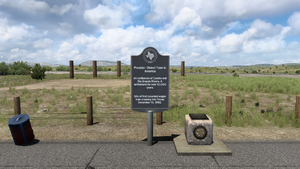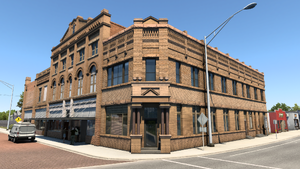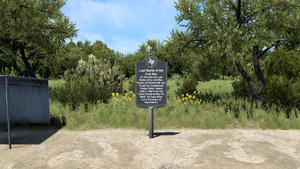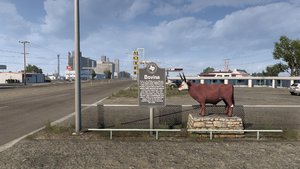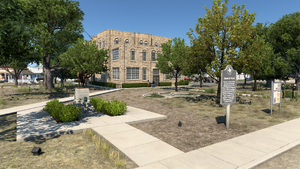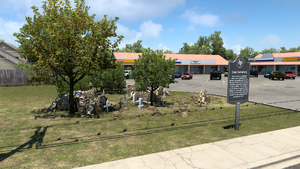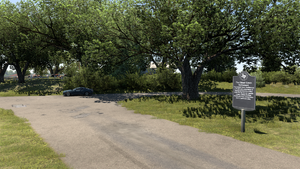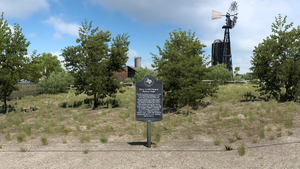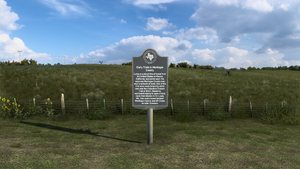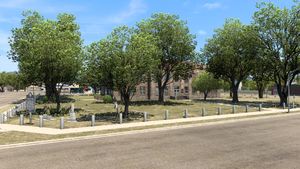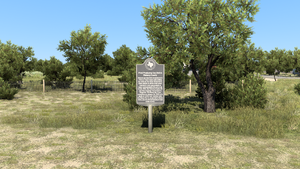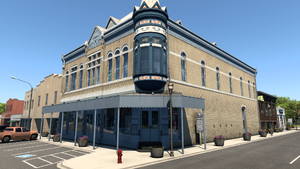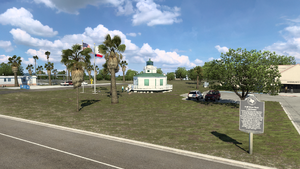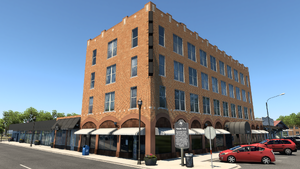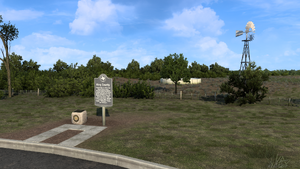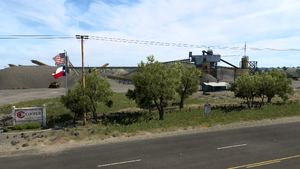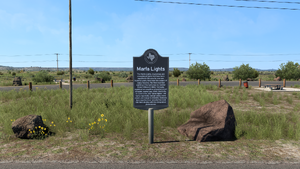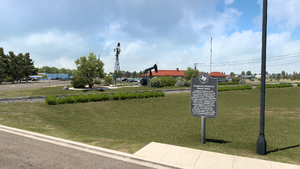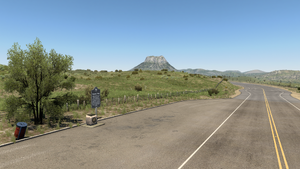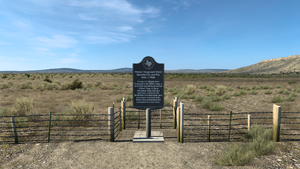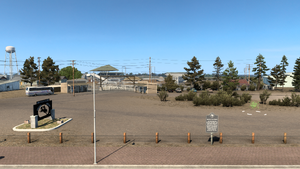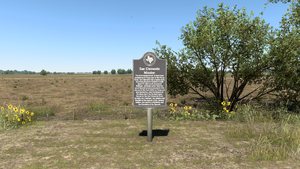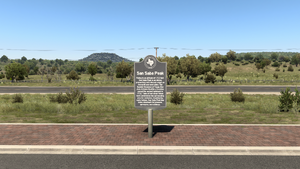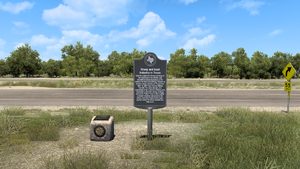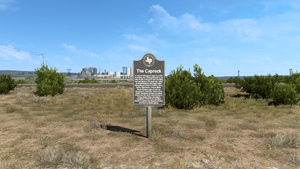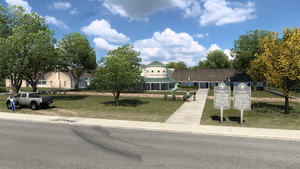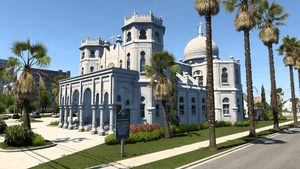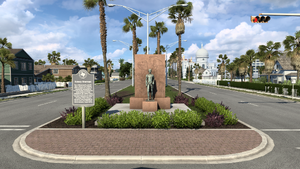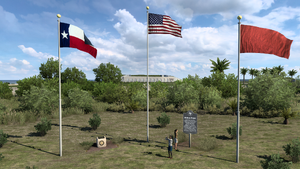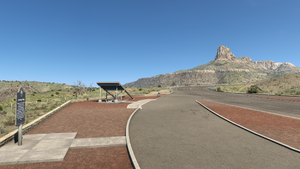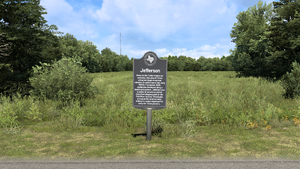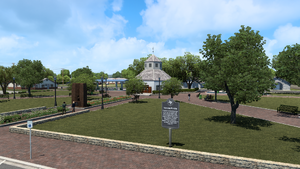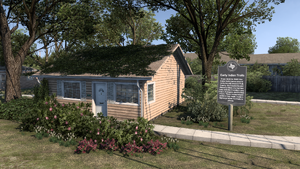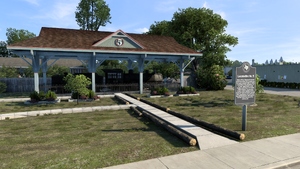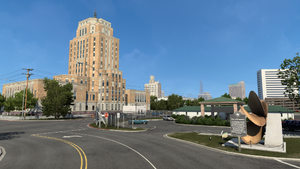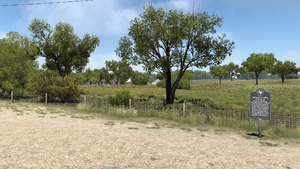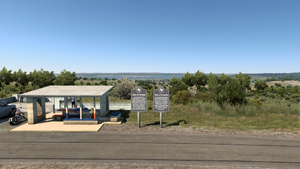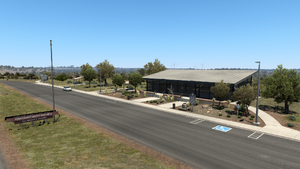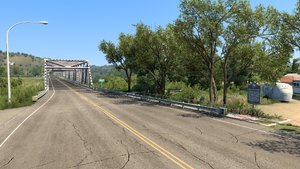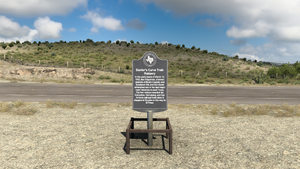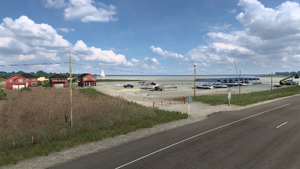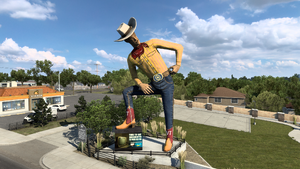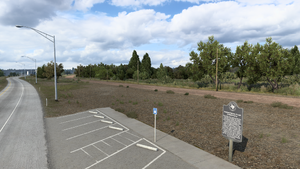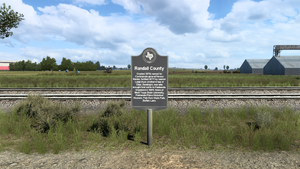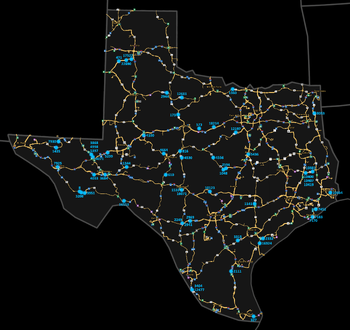Texas Historical Marker Program
Jump to navigation
Jump to search
This page contains the complete list of Historical Markers from Texas's Historical Marker Program that are featured in the Texas map expansion DLC for American Truck Simulator.
List
The list contains an image and the location of each Historical Marker featured in the game and an exact copy of its title, description, and sign number. The sign number is marked on a separate brown guide sign indicating the presence of a Historical Marker. When such a sign is absent in the game, the sign number has been retrieved from the official Texas Historic Sites Atlas.
| # | Title | Description | Location | Image |
|---|---|---|---|---|
| 8 | Presidio - Oldest Town in America | At confluence of Concho and Rio Grande Rivers. A settlement for over 10,000 years. Site of first recorded wagon train crossing into Texas, December 10, 1582. | ||
| 173 | Anson Opera House | Built 1907 by A.W . Johnson and Dr. D. Williams, with Thomas Vetch, contractor. House was site for diverse programs: stock company and Chautaugua productions such as "East Lynn" and "The Klansman" (for which Sheriff Tom Hudson's horse was borrowed and led on stage); "Perils of Pauline" and other silent moving pictures; a state championship wrestling match in era of local pugilist Boomer Moore; and Anson High School's first (1909) graduation. | ||
| 327 | Last Battle of the Civil War | At This Site the Last Battle of the Civil War, Known as Palmito Hill, was Fought by Confederate Troops Under Colonel John S. (Rip) Ford and Union Forces on May 13, 1865, 34 Days After Lee's Surrender at Appomattox. | ||
| 471 | Bovina | Early in the 20th century, this was one of largest cattle shipping points in the United States. The Pecos & Northern Texas Railroad built to this point in 1898, and cattle for eastern markets were loaded here. Train crews called the place "Bull Town", but the community chose the name "Bovina" when establishing the post office in 1899. It is now market and supply center for rich area of irrigated farms, and still produces fine cattle. | ||
| 573 | Burkett Pecan Tree | Bred from a native tree, 1900, by J. H. Burkett (1861-1945), Texas pecan industry leader. | Secret road east of Abilene | |
| 610 | Christopher Columbus Doty | First permanent citizen of Schleicher County. Drilled first water well in county 1882. | ||
| 816 | Charles H. Noyes | Charles H. Noyes, 21, died when his horse fell while rounding up cattle on the Noyes' Ranch. His father and mother, Gus and Lula Noyes, erected monument in 1919 as a tribute to their son and all Texas cowboys. Pompeo Coppini of Chicago studied horses two years before sculpturing statue. | ||
| 1048 | Cook Cemetery | This cemetery, Lampasas' oldest, was established as a pioneer community graveyard in the mid-1850s. The first marked burial here was that of Rebecca Hughes in 1854. The cemetery is named after Arkansas natives William M. and Cynthia Cook who moved to Texas about 1856 and bought the land containing this graveyard in 1861. | ||
| 1141 | The Oldest Czech Settlement | The Oldest Czech Settlement in Texas was established at Hostyn when in November 1856 the families of Joseph Janda, Valintin Kolibal, Frantisek Koza arrived here from Czechoslovakia. | ||
| 1344 | Early Humble Camp in Permian Basin | The World's largest complex of oil wells in the 1920s was developed in this area. Key to success of this vast petroleum field lay in finding ways to convey oil to growing fuel markets. First efficient transportation came in 1925 with the laying of the Humble pipeline from Kemper Station, near Big Lake, to Comyn Station (a distance of about 500 miles), to connect with existing Comyn-Baytown system. Today in Texas, Humble has 15,000 oil and gas wells; 9,545 miles of pipeline; and one refinery. | ||
| 1360 | Early Trails in Montague County | Lying on a direct line of travel from the United States to Mexico, California, and points west, the area now Montague County was once a network of trails. One of the first area roads forged by white men was the Chihuahua Traders Trail of 1840. Blazed by merchants hoping to open a trade route from Mexico to St. Louis, Mo., this road crossed present Montague County and left tracks for later travelers. | ||
| 1435 | El Paso Salt War | Resentment over private control of the salt lakes in this region, led to the El Paso Salt War. | ||
| 1533 | First Post Office | Across the street, south, was the first building erected to house the junction post office. Junction's first postmaster, Mrs. Harriet kountz, appointed 1876, at first kept the mail in her home. In 1879, her husband dr. Ezekiel kountz, built a post office, drugstore, and general mercantile house on the square. | ||
| 2111 | First Producing Gas Well in Kleberg County | Natural gas was first encountered in 1912 by Frank House while drilling for water on the Oscar Rosse farm. Other efforts to obtain fresh water resulted in more gas pockets or water contaminated with salt or oil. In Oct. 1919, the Kleberg County Oil and Gas Company was formed in Kingsville. The Rosse No. 1 was completed on January 16, 1920, at a depth of 3,000 feet. Another well, the Rosse No. 2, completed in March 1920, was the first producing oil well in the county. | ||
| 2249 | Grand Opera House | Staged outstanding musicals, dramas. Built 1891 by local men for professional troupes. Also scene of home talent plays, some directed by Ben K. Franklin, a former actor who settled here. Programs created social stir, with lavish dress and parties. Building has copper roof and corbeled bay window tower; had ornate stage and auditorium. Now owned by former U.S. Vice President John Nance Garner and his son, Tully Garner. | ||
| 2332 | Half Moon Reef Lighthouse | Constructed in 1858, this three-story hexagonal lighthouse was originally located in Matagorda Bay, at the southern tip of Half Moon reef. The beacon served as an aid to ships trading in Port Lavaca and the nearby town of Indianola (14 mi. SE). During the Civil War the light was disabled by Confederate troops in an attempt to disrupt federal efforts to capture southern blockade runners. The lighthouse was restored to full operation in 1868 and remained in service until 1943. | ||
| 2594 | Hughes' Springs | One of the Lampasas sulphur springs named in honor of first settler in this vicinity in 1853, Moses Hughes, whose wife regained health through its waters. | ||
| 2941 | Kincaid Hotel | This four-story hotel building was constructed in 1927 by the family of William Davis "Billy" Kincaid in memory of his life as a prominent Uvalde cattleman, businessman, and civic leader. The Kincaid Hotel became a popular place for business meetings, banquets, and social gatherings. Ranchers and cattle traders made the Kincaid lobby their meeting place. The hotel has served such noted guests as Texas Governors, Congressional leaders, President Lyndon Johnson, and movie personalities, including Ronald Reagan. | ||
| 2944 | King County | Created Aug. 21, 1876, from Bexar County, whose diamond-shaped boundaries extended from the Rio Grande to the Panhandle to El Paso. Named for William King, who died at the Alamo. Chief industry, ranching, is reflected in its famous cattle brands: "6666," "Pitchfork," "SMS," and "Matador". | ||
| 2969 | Knippa Trap Rock Plant | Volcanic lava deposited here more than 60 million years ago cooled and hardened over time to form basalt, a dark igneous rock also known as trap rock. M. B. (Pete) Walcott purchased acreage here about 1904 and in 1907 formed the Genevieve Mining Co. to search for gold. Although little gold was found, substantial quantities of high quality trap rock were discovered. The Texas Trap Rock Company established a quarry about 1911 and shipments of rock began in 1912. A large highly-visible screening house was completed in 1914. | ||
| 3208 | Marfa Lights | The Marfa Lights, mysterious and unexplained lights that have been reported in the area for over one hundred years, have been the subject of many theories. The first recorded sighting of the lights was by rancher Robert Ellison in 1883. Variously explained as campfires, phosphorescent minerals, swamp gas, static electricity, St. Elmo's fire, and "ghost lights", the lights reportedly change colors, move about, and change in intensity. Scholars have reported over seventy-five local folk tales dealing with the unexplained phenomenon. | ||
| 3315 | Medio Creek | Named by the Spaniards about 1800 because of its midway position between the San Antonio and Nueces Rivers. | ||
| 3404 | Zapata County | Created 1858, named in honor of Antonio Zapata, a pioneer stockman of the region. | ||
| 3684 | Oil and Gas Industry in Pecos County | Located in the petroleum-rich Permian Basin, Pecos is one of the most prolific oil- and gas-producing counties in Texas. The petroleum business here began about 1900 with the drilling of the Turney well near an ancient "seep", a traditional local source of oil for lubricating and medicinal purposes. A short-lived boom in 1921 caused by the discovery of the "Miracle Well" heralded the arrival of the fabulous Yates oil field (1926), indicating the area's great potential oil wealth. | ||
| 3868 | Orient Hotel | "Finest from Ft. Worth to El Paso." Saloon built 1896 of Pecos Valley red sandstone. Hotel opened 1907 by R. S. Johnson, owner. Headquarters for land promoters, salesmen, families of settlers in early years of Pecos Valley development. Restored to House West of the Pecos Museum. | ||
| 3951 | Paisano Pass | Legend recounts that two Spaniards meeting here greeted each other "Mi Paisano" (My Countryman). First known to history when Juan Dominguez de Mendoza camped here on January 3, 1684. Well known after 1850 as a point on the Chihuahua Trail, an emigrant road to California. | ||
| 4033 | Pioneer Stagecoach Stand Operators Mr. and Mrs. Isaac J. Rude | On way to California from Tennessee in the 1850's Isaac J. and Sarah Isabella Rude settled in West Texas. In Davis Mountains, Rude built and operated a station for the Butterfield Overland Stage; here passengers had meals while mules were unharnessed and exchanged for a fresh team. | ||
| 4071 | World's First Rodeo | Held a block south of Pecos Courthouse, July 4, 1883. Started with claims of cattle outfits -- Lazy, Na and W Ranch -- that each had fastest steer ropers. Settlers in town for Fourth of July picnic were spectators. The prizes were blue ribbons cut by pocket knife from new dress of a 4-year-old girl in crowd. Best roper was Morg Livingston, of the Na. Trav Windham, Lazy Y was second. | ||
| 4100 | Potton House | Joseph Potton, a native of England, built this Victorian residence in 1901 | ||
| 4530 | San Clemente Mission | The first mission known to have been established in Texas east of the Pecos River, San Clemente was a hastily built, two-room structure located on a hill about 17 miles south of present Ballinger. Although earlier than the great Spanish mission movement, this was one of the first (1684) in Texas and was founded by Juan Dominguez de Mendoza and Fray Nicolas Lopez. Named for the San Clemente River (actually the Colorado), the mission was founded at the request of the Jumano Indians, who desired Christianity and the friendship of the Spanish. | ||
| 4556 | San Saba Peak | Rising to an altitude of 1,712 feet, San Saba Peak is an oblong promontory with rimrock edges on the north and west sides. The Spanish Governor of Texas, Don Juan Antonio Bustillo y Cevallos, named the ancient landmark in 1732. Tales of lost silver mines have centered on the surrounding area for centuries. Inhabited by early Indians, San Saba Peak has been a landmark for pioneers, surveyors, and cowboys. | ||
| 4664 | Sheep and Goat Industry in Texas | Spanish explorers introduced sheep to the Soutwest in the 1500s, and Spanish missions depended on the animals for food and clothing. Pioneer of modern sheep ranching in Texas from 1857 to 1867 was George Wilkins Kendall. The land, climate, and vegetation of the Edwards Plateau area especially suited the raising of sheep and goats. Today Texas is the leading producer of sheep and goats in the nation, and San Angelo is the major market center for these animals and their wool. | ||
| 4998 | Spanish Explorers | Antonio De Espejo in 1583, after exploring among pueblos in New Mexico, reached the Pecos River southeast of Santa Fe. He Named it Rio de Las Vacas (river of cows), for the abundance of buffalo. On his return route to Mexico he went down the river to near the present town of Pecos. Jumano Indians led his party to their camp on Toyah Lake. He then went down Toyah Creek and through the Big Bend. | ||
| 5299 | The Caprock | A range of flat-topped ridges and cliffs stretching from Texas panhandle to 20 miles South of this point and extending into new Mexico. The name also refers to tough limestone that caps ridges. Rising sharply 200 to 1,000 ft. above plains. This section, Concho Bluffs, Marks Western edge of Caprock escarpment. Called the "Break of the plains" because it divides the staked plains from the north central plains of Texas. Observed by Coronado's expedition, 1540-1540, provided shelter in storms, but delayed entrance of settlers to staked plains. | ||
| 5397 | The Pecos Cantaloupe | Nationally famed melon, originated in this city. Residents from 1880s grew melons in gardens, noting sun and soil imparted a distinctive flavor. In 1917 Todd and partner, D. T. McKee, grew eight acres of melons, selling part of crop to dining cars of Texas & Pacific Railway, where Pecos cantaloupes first became popular and in wide demand. Presidents Eisenhower and Johnson and many other distinguished persons have ordered and appreciated Pecos cantaloupes. | ||
| 5436 | The Texas Rangers and the Fence Cutters | Before 1875 in Texas, cattle roamed over thousands of acres of public land, and free grazing became a tradition. After 1875, however, an increasing farm populace tended to protect crops and other property with barbed wire fences which were resented by stockraisers. Cattle losses in drouths of the 1880s provoked such widespread cutting of fences that the Texas government recognized this as a crime. Texas Rangers were dispatched by the Governor at the call of County Judges and Sheriffs to apprehend the fence cutters. Rangers operated from the Red River to the Rio Grande, and from the Panhandle to the Pine Woods of East Texas. Disguise and concealment were required, and one of the Rangers who won praise for his work pronounced it the most disagreeable duty in the world. The vigorous effort went on for some years. Finally, however, stockmen who had wanted to restore the open range were won over to fencing their own lands and using windmills to water their cattle herds. The Texas Rangers had in one more instance helped to stabilize life in the West. | ||
| 7170 | Sacred Heart Church | The earliest Catholic services in the Galveston area were conducted in 1838. The present building, the second for the parish, was constructed in 1903-04 during the pastorate of the Rev. D. J. Murphy. A prominent landmark in the city. The design reflects influences of the Moorish, Byzantine, Gothic and Romanesque styles. | ||
| 7183 | Sidney Sherman | Born in Massachusetts July 23, 1805. Came to Texas February 1836 as captain of a company of volunteers he had recruited in Kentucky and Ohio. Commanded the Second Regiment of Texas Volunteers at San Jacinto. First to sound the immortal war cary opening the battle. Remember the Alamo. Remember Goliad. Father of railroads in Texas, having built the first one west of the Sabine River. Died in Galveston, Texas in 1873. | ||
| 7452 | Bolivar Point | In 1815 Colonel Henry Perry established a military camp here as part of a plan to invade Spanish Texas. While commanding a filibuster to win Texas independence, James Long established Fort Las Casas on Bolivar Point in 1820-21. His wife, Jane Herbert (Wilkinson), gave birth to a daughter, Mary James, in December 1821 at the fort. Mary James Long is often referred to as the first Anglo child born in Texas. | ||
| 7925 | Clark Hotel | First permanent structure in Van Horn. Earliest portion (built 1901) housed original city post office. | ||
| 7930 | Guadalupe Peak | Guadalupe Peak, Texas' highest mountain at 8,751 feet, dominates one of the most scenic and least-known hinterlands of the old frontier. It lies behind and to the right of 8,078-foot El Capitan, the sheer cliff that rises more than 3,000 feet above this spot to mark the south end of the Guadalupe range. | ||
| 8053 | Jefferson | Home to the Caddo Indians for centuries, this area of Texas attracted Anglo-American colonists to settle here in the early 1800s. Founded in 1839, Jepfferson developed along a double-grid pattern. Jefferson was a center of commerce and an important shipping point on the Red River system. Riverboats arrived at the wharves daily, making it a major inland port of entry for Texas pioneers. | ||
| 10123 | Vereins Kirche | Church for all denominations, school and community hall. Built, summer 1847, after the Comanche peace treaty made by John O. Meusebach, Commissioner, German Emigration Company. Replica, first used as museum and library, constructed 1934-35. | ||
| 10381 | Village of the Alabama and Coushatti Indians | Who came into Texas early in the 19th century and have always been friendly with the whites. | ||
| 10400 | Early Indian Trails | From 1830 to 1840 five Indian trails (some several centuries old) crossed Polk County. the Coushatta and Alabama tribes started two trails and also traveled Long King's, Kickapoo, and Battise traces. These routes helped settlers map roads; modern highways follow the trails in places. | ||
| 10407 | Locomotive No. 5 | Built in 1911 by Philadelphia's Baldwin Locomotive Works, this locomotive was first used to transport timber in Florida. In the 1920s, it was purchased for use in Texas' logging industry by the Angelina County-based Carter-Kelley Lumber Company. The locomotive traveled between Angelina and Polk County mill towns on Houston, East and West Texas Railway tracks, picking up logs and finished lumber that frequently had been hauled from local cutting areas by oxen. | ||
| 10419 | Polk County | During Civil War, 1861-65, an area of piney woods, farms, thickets, with an Alabama-Coushatta Indian reservation. | ||
| 10554 | Port of Beaumont | The city of Beaumont, 41 miles inland from the Gulf of Mexico, was served from its founding in 1837 by schooners and sternwheelers navigating the Neches River. The three-foot depth of Sabine Lake between the river's mouth and the Gulf limited passage to shallow-draft vessels. Surveys after 1852 recommended navigation improvements, and dredging of a 12-foot-deep channel at Sabine Pass began in 1876. The deep water port and Sabine-Neches waterway were officially opened in 1916. | Franklin Street in Beaumont | |
| 12197 | Barnard's Trading Post No. 2 | The Torrey brothers of Connecticut and their childhood friend George Barnard, with President Sam Houston as a partner, contracted to build a series of trading posts along the Brazos River in 1843. Barnard's friendly manner made the Indians his friends, paving the way for more peaceful frontier settlement. | ||
| 12477 | Site of Uribeño | One of five Zapata County settlements inundated by the waters of Falcon Reservoir in the 1950s, Uribeño traces its origin to 1803, when Porción 41 was granted to Jose Nicolas Clemente Gutierrez de Lara (1770-1805) for his service in the Spanish army. As required by the terms of the grant, Jose Nicolas Clemente worked to establish a ranch on his property against the odds of Indian raids, scorching heat, drought and periodic river flooding. Jose Nicolas Clemente returned to his hometown of Revilla in Mexico just prior to his death, leaving behind his widow, Maria Josefa Martinez, and six children. After the Mexico independence war, some of his sons returned to the ranch; which was named Uribeño. By 1860, the population of the Uribeño community was 152. When the United States government built Falcon Dam, Uribeño met the same fate as its neighboring towns. | ||
| 12681 | Texas Business Pioneer Pleasant C. Sams | (1845 - 1921) In 1850's came to Texas from Arkansas. At 16, on outbreak of Civil War, was left in charge of family mills, instructed by his father to give entire flour output to widows of Confederates. In 1862, captured in Missouri, as he went through enemy lines to get his bride; "escaped" from Federal who also admired bride. Wedding trip was horseback ride to Texas. Pioneer cattlemen; business and financial leader. | ||
| 16071 | South Llano Crossing | The spanning of the South Llano River has been a major concern for the citizens of Junction since the town's founding in 1876. Although earlier bridges existed along this stretch of the river, a bridge built in 1916 accommodated travelers along the transcontinental Old Spanish Trail Highway. When the 1916 bridge became functionally obsolete, another modern bridge was completed in 1937. | ||
| 16553 | Baxter's Curve Train Robbery | In the early hours of March 13, 1912, Ben Kilpatrick, a former sidekick of Butch Cassidy and Sundance Kid, and Ole Hobek attempted one of the last major train robberies in west Texas. The two robbers boarded the Galveston, Harrisburg, and San Antonio railroad train when it stopped at Dryden on the way to El Paso. | ||
| 16924 | Mills Wharf | Mills Wharf, built by John Howard Mills in 1932, was a renowned center for waterfowl hunting and fishing from the 1930s until it was sold in 1960. It consisted of cottages, a cook house, a guide service office, a store, a tackle shop, and a unique wildlife museum with a famous duck, featured in "Ripley's believe it or not," which had an oyster permanently attached to its foot. | ||
| 17522 | Tex Randall | The 47-foot, seven-ton cowboy statue, known as Tex Randall, is considered a Texas icon. Designer and builder Harry Wheeler created the cowboy in 1959 as a roadside phenomenon to welcome travelers to his Corral curio shop on U.S. Highway 60 west to New Mexico. The giant cowboy relates to the western heritage of the Texas panhandle as well as symbolizing the state of Texas. | ||
| 18214 | Bankhead Highway through Eastland County | Early 20th century development of the automobile led to major road system improvements throughout the United States. The Bankhead Highway became an east-to-west transcontinental highway from Washington, D.C. to San Diego. The Bankhead Highway's route through Texas included the major cities of Texarkana, Dallas, Fort Worth and El Paso. As the highway entered Eastland County from the east, a narrow, winding and extremely steep feature known as Thurber Hill, Ranger Hill or the "Big Hill" was one of the first challenges for early automobiles. | ||
| 22690 | Randall County | Created 1876; named for Confederate general Horace Randal. Settled 1877 by rancher Leigh Dyer, brother-in-law of Chas. Goodnight, man who brought first cattle to Panhandle. Organized in 1889. Home of West Texas State University, Panhandle-Plains Historical Museum, Palo Duro State Park, Buffalo Lake. |
Map
The blue dots, accompanied by their sign numbers, mark all Historical Markers in Texas.
Achievements
The achievement Avid Historian requires the player to discover 30 Historical Markers.

